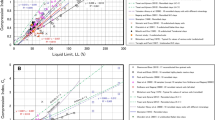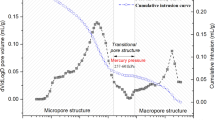Abstract
This study aims at establishing the hydraulic conductivity–effective vertical stress–void ratio interrelations for naturally sedimented clays under one-dimensional condition. The roles of soil structure developed during the depositional and the post-depositional processes in both the relationships of hydraulic conductivity versus effective vertical stress and void ratio versus effective vertical stress are investigated. It is found that the soil structure effect on the hydraulic conductivity–effective vertical stress curves can be attributed to that on the compression curves. The effect of initially deposited state on the hydraulic conductivity is also linked with that on the void ratio for naturally sedimented clays under the same values of effective vertical stress. The investigations indicate that the interrelation between hydraulic conductivity and compressibility is independent of initial state. That is, the hydraulic conductivity–void ratio relationship of naturally sedimented clays is independent of soil structure and initial state. Such a relationship is found to be a function of void ratio at liquid limit. Consequently, the hydraulic conductivity can be estimated based on the hydraulic conductivity–void ratio database established for naturally sedimented clays with a wide spectrum of void ratio at liquid limit. An empirical way of determining hydraulic conductivity is also proposed for naturally sedimented clays. A series of one-dimensional incremental load consolidation and hydraulic conductivity tests were performed. These data together with those compiled from the literature are used for investigating the accuracy of the suggested methods of determining hydraulic conductivity.

















Similar content being viewed by others
Abbreviations
- c v :
-
Coefficient of consolidation
- e :
-
Void ratio
- e L :
-
Void ratio at liquid limit
- e n :
-
In situ void ratio
- e vn :
-
Void ratio of natural clays
- e vr :
-
Void ratio of reconstituted clays
- e 0 :
-
Initial void ratio of reconstituted clays
- k v :
-
Hydraulic conductivity in vertical direction
- k vn :
-
Hydraulic conductivity of natural clays
- k vn-ca l culated :
-
Hydraulic conductivity of natural clays determined by empirical evn–kvn equation
- k vn-estimated :
-
Hydraulic conductivity of natural clays determined using evn–kvn database
- k vn-measured :
-
Measured hydraulic conductivity of natural clays
- k vr :
-
Hydraulic conductivity of reconstituted clays
- k vr-ca l culated :
-
Hydraulic conductivity of reconstituted clays determined by empirical evn–kvn equation
- k vr-measured :
-
Measured hydraulic conductivity of reconstituted clays
- PI :
-
Plasticity index
- w L :
-
Liquid limit
- w n :
-
In situ content
- w P :
-
Plastic limit
- w 0 :
-
Initial water content of reconstituted clays
- σ v :
-
Vertical stress
- σ' v :
-
Effective vertical stress
- 1DIL:
-
One-dimensional incremental load
References
Atkinson JH, Bransby PL (1978) The mechanics of soil: an introduction to critical state soil mechanics. McGraw-Hill Book Company (UK) Limited, England
Burland JB (1990) On the compressibility and shear strength of natural clays. Géotechnique 40(3):329–378
Butterfield R (1979) A natural compression law for soils. Géotechnique 29(4):469–480
Carrier WD, Beckman JF (1984) Correlations between index tests and the properties of remoulded clays. Géotechnique 34(2):211–228
Chai JC, Agung PMA, Hino T, Igaya Y, Cater J (2011) Estimating hydraulic conductivity from piezocone soundings. Géotechnique 61(8):699–708
Dolinar B (2009) Predicting the hydraulic conductivity of saturated clays using plasticity-value correlations. Appl Clay Sci 45:90–94
Fox EJ (1996) Analysis of hydraulic gradient effects for laboratory hydraulic conductivity testing. Geotech Test J 19(2):181–190
Head KH (1992) Manual of soil laboratory testing: soil classification and compaction tests, 2nd edn. Pentech Press Limited, London
Hong PY, Pereira JM, Tang AM, Cui YJ (2016) A two-surface plasticity model for stiff clay. Acta Geotech 11(4):871–885
Hong ZS, Yin J, Cui YJ (2010) Compression behaviour of reconstituted soils at high initial water contents. Géotechnique 60(9):691–700
Hong ZS, Zeng LL, Cui YJ, Cai YQ, Lin C (2012) Compression behaviour of natural and reconstituted clays. Géotechnique 62(4):291–301
Leroueil S, Tavenas F, Brucy F, La Rochelle P, Roy M (1979) Behavior of destructured natural clays. J Geotech Eng. 105(6):759–778
Leroueil S, Diene M, Tavenas F, Kabbaj M, La Rochelle P (1988) Direct determination of the permeability of clay under embankments. J Geotech Eng 114(6):645–657
Leroueil S, Vaughan PR (1990) The general and congruent effects of structure in natural soils and weak rocks. Géotechnique 40(3):467–488
Leroueil S, Bouclin G, Tavenas F, Bergeron L, La Rochelle P (1990) Permeability anisotropy of natural clays as a function of strain. Can Geotech J 27(5):568–579
Leroueil S, Leart P, Hight DW, Powell JJM (1992) Hydraulic conductivity of a recent estuarine silty clay at Bothkennar. Géotechnique 42(2):275–288
Liu MD, Carter JP (1999) Virgin compression of structured soils. Géotechnique 49(1):43–57
Liu MD, Carter JP (2000) Modelling the destructuring of soils during virgin compression. Géotechnique 50(4):479–483
Mitchell JK, Soga K (2005) Fundamentals of soil behavior, 3rd edn. Wiley, USA
Nagaraj TS, Srinivasa Murthy BR (1986) A critical reappraisal of compression index equation. Géotechnique 36(1):27–32
Nagaraj TS, Pandian NS, Narasimha Raju PSR (1993) Stress state–permeability relationships for fine-grained soils. Géotechnique 43(2):333–336
Nagaraj TS, Pandian NS, Narasimha Raju PSR (1994) Stress–state–permeability relations for overconsolidated clays. Géotechnique 44(2):349–352
Pane V, Croce P, Znidarcic D, Ko HY, Olsen HW, Schiffman RL (1983) Effects of consolidation on permeability measurements for soft clay. Géotechnique 33(1):67–72
Shi XS, Herle I (2017) Numerical simulation of lumpy soils using a hypoplastic model. Acta Geotech 12(2):349–363
Shi XS, Nie J, Zhao J, Gao Y (2020) A homogenization equation for the small strain stiffness of gap-graded granular materials. Comput Geotech 121:103440
Siddique A, Safiullah AMM (1995) Permeability characteristics of reconstituted Dhaka clay. J Civil Eng Div 23(1):103–115
Tavenas F, Leblond P, Jean P, Leroueil S (1983) The permeability of natural soft clays Part I: methods of laboratory measurement. Can Geotech J 20(4):629–644
Tavenas F, Leblond P, Jean P, Leroueil S (1983) The permeability of natural soft clays. Part II: permeability characteristics. Can Geotech J 20(4):645–660
Zeng LL, Hong ZS, Cai YQ, Han J (2011) Change of hydraulic conductivity during compression of undisturbed and remolded clays. Appl Clay Sci 51(1–2):86–93
Zeng LL, Hong ZS, Cui YJ (2015) Determining the virgin compression lines of reconstituted clays at different initial water contents. Can Geotech J 52(9):1408–1415
Zeng LL, Hong ZS, Gao YF (2017) Practical estimation of compression behaviour of dredged clays with three physical parameters. Eng Geol 217:102–109
Zeng LL, Wang H, Hong ZS (2020a) Hydraulic conductivity of naturally sedimented and reconstituted clays interpreted from consolidation tests. Eng Geol 272(105638):1–9
Zeng LL, Cai YQ, Cui YJ, Hong ZS (2020b) Hydraulic conductivity of reconstituted clays based on intrinsic compression. Géotechnique 70(3):268–275
Znidarcic D, Schiffman RL, Pane V, Croce P, Ko HY, Olsen HW (1986) The theory of one-dimensional consolidation of saturated clays: part V, constant rate of deformation testing and analysis. Géotechnique 36(2):227–237
Acknowledgements
This study is supported by the National Natural Science Foundation of China (Grant No. 41977243) and FOK YING TUNG Education Foundation (Grant No. 161070).
Author information
Authors and Affiliations
Corresponding author
Additional information
Publisher's Note
Springer Nature remains neutral with regard to jurisdictional claims in published maps and institutional affiliations.
Rights and permissions
About this article
Cite this article
Zeng, LL., Ji, F., Wang, H. et al. Estimating hydraulic conductivity of naturally sedimented clays using compression curves. Acta Geotech. 17, 1815–1827 (2022). https://doi.org/10.1007/s11440-021-01306-6
Received:
Accepted:
Published:
Issue Date:
DOI: https://doi.org/10.1007/s11440-021-01306-6




